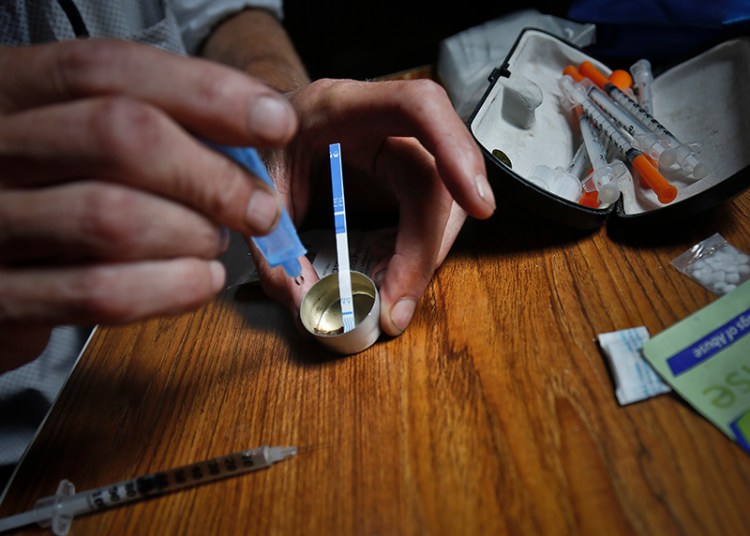Illicit drug users who are certain that fentanyl is mixed into the heroin they consume are much more likely to take precautions that reduce their chances of overdosing, researchers reported Wednesday in a small study.
The survey examined the use of fentanyl test strips by 125 injection drug users in Greensboro, North Carolina, over a two-month period last year. Distribution of the small strips has become an increasingly popular “harm reduction” technique in the past few years among groups trying to protect drug users from overdosing on the powerful narcotic that has swept most of the United States.

Sales of fentanyl test strips have exploded as a growing number of overdose-prevention programs hand them out to people who use illicit drugs.
Users whose drugs tested positive for fentanyl were five times as likely to change their behaviors than users whose strips were negative, according to the team led by researchers from RTI International, a think tank in North Carolina’s Research Triangle Park.
The users’ precautions included taking a small “test shot,” using less of the drug mixture, pushing the syringe plunger in more slowly and snorting instead of injecting the drugs, the researchers reported. None of the respondents – who were habitual drug users – threw away their drugs.
“The illicit market is basically poisoned” by fentanyl, said Jon E. Zibbell, one of the leaders of the research. “These strips allow people to test their product to see if fentanyl is in it. Knowing what is in your product is the first step to being able to adapt to that product.”
The research is scheduled for publication Wednesday morning in the International Journal of Drug Policy.
In February, the Harm Reduction Coalition in San Francisco reported in a less formal survey that a pilot program of test strip distribution also had resulted in behavior changes and more awareness of fentanyl in that city’s drug supply.
Opioid overdoses killed more than 49,000 people in 2017, according to preliminary data released in August by the Centers for Disease Control and Prevention. Synthetic opioids such as fentanyl, which dealers mix with powdered heroin and other drugs, are mainly responsible for the record number of deaths and the worst drug epidemic in U.S. history.
U.S. public health authorities have focused harm-reduction efforts on ever-widening distribution of naloxone, the fast-acting antidote for overdoses, and needle exchanges, which reduce infections by providing users with clean syringes.
Canada, Australia and some European countries also have “supervised injection sites,” where trained staff monitor users while they take drugs and respond to overdoses. Those are illegal under U.S. law, and California Gov. Jerry Brown, a Democrat, vetoed a bill Sunday that would have allowed cities in his state to open them.
But mayors in some cities where overdoses are rampant say the fight is not over. On Tuesday, former Philadelphia mayor Ed Rendell said he would incorporate a nonprofit organization that will seek private funding for a supervised injection site in that city.
The test strips were originally designed for doctors, who used them to test the urine of patients to make sure they were taking prescription fentanyl, which is used as a pain medication, and not selling it. But as illegal fentanyl poured into North America in concentrations that varied widely from dealer to dealer, harm-reduction groups began offering them in 2016 to test for fentanyl in heroin and other drugs. Users dip the strips into a mixture of drugs and water, usually – but not always – before they inject.
Iqbal Sunderani, chief executive of Canada’s BTNX, the main commercial provider of the strips, said his company has sold more than 650,000 test strips in the United States this year, nearly six times the 2017 total. He now sells many more strips to harm-reduction groups and city and state governments than he does to physicians, he said.
The strips, which sell for a dollar apiece, can detect even small amounts of nine different fentanyl analogues, Sunderani said, including carfentanil, which is 10,000 times as powerful as morphine.
The strips offer users something that naloxone and trips to the emergency room can’t: A way to know whether they are consuming fentanyl before they do it, Zibbell said. “Right now there’s no intervention for people prior to using,” he said. A positive test result and taking the time to conduct the test both helped people change their behaviors, he added.
The RTI survey and a February 2018 survey by the Johns Hopkins Bloomberg School of Public Health showed that while some users actively sought fentanyl, most were concerned about the danger it posed.
The strips in the RTI research were distributed by Greensboro’s Urban Survivors Union, which offers clean syringes and other services, in September and October of 2017. Drug users answered an online survey at the group’s headquarters.
Overall, 43 percent of the users reported that they had changed their drug consumption behavior, and 77 percent said that the test strips made them feel safer, according to the survey.
The researchers concluded that use of the strips “can follow the path of syringe exchange and lay naloxone distribution, interventions initially developed by harm reduction activists and organizations” before they were adopted by public health agencies.
Copy the Story LinkSend questions/comments to the editors.



Success. Please wait for the page to reload. If the page does not reload within 5 seconds, please refresh the page.
Enter your email and password to access comments.
Hi, to comment on stories you must . This profile is in addition to your subscription and website login.
Already have a commenting profile? .
Invalid username/password.
Please check your email to confirm and complete your registration.
Only subscribers are eligible to post comments. Please subscribe or login first for digital access. Here’s why.
Use the form below to reset your password. When you've submitted your account email, we will send an email with a reset code.